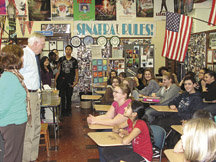The students at Weehawken High School have been involved in a lot of philanthropy this year: drives for Haiti, fundraisers for cancer, and collections for the homeless.
“There are so many things they’re involved in,” said Jon Hammer, a teacher at the high school, last week. “They’re very generous and caring.”
Hammer can attest to the students’ generosity because he’s seen it first hand. As the math, science, and social studies teacher for the seventh grade Academically Talented class at Weehawken High School, Hammer tries to get the kids tangibly involved with their learning process.
One lesson has recently come alive in a very real way for the kids. It was sparked by a discussion Hammer had with them after the Veterans Day parade in November.
Last year was the first time the parade featured members of the Navajo Code Talkers, a group of young Navajo men who helped the United States win World War II by creating an unbreakable code to use on the battlefield.
There are only 50 code talkers left in the country.
________
After learning more about the code talkers and their mission to create a museum, the seventh and eighth grade Academically Talented classes decided to work together to raise $1,000 to help the Navajo Code Talkers realize that dream.
Only 50 of them left
“There’s only 50 [code talkers] left,” said Genna Fukuda in a class discussion earlier this month.
“It’s a great cause,” added Emily Chong.
The students have already raised $250 in donations before truly getting their fundraising efforts underway. To raise the remainder of the $1,000 the group will be holding a series of bake sales, for which the students will all bring in homemade goodies to sell in the school hallways.
“I hope that people would take into consideration all that the [code talkers] have done for us,” said Mithin Nair. “And will help us reach our goal.”
In addition to the bake sales, the students are looking for other fundraising ideas and monetary donations, perhaps seeking local veterans who want to participate.
Aabha Gami said that raising money for the museum is a worthy cause and hopes that the fundraiser will inspire others throughout the school to care.
“I think they’re worth it,” said Gami. “They helped us a lot to build our country today.”
Cause for action
World War II is not in the curriculum for seventh and eighth graders, but Hammer felt it was important to make the students aware of this important piece of history.
“It’s important not only to learn about the war,” said Hammer. “But also to save those who saved us.”
Hammer, who is also the director of the Kid Witness News journalism program at the school, has been working with partner and Program Coordinator Linda Shertel in the Academically Talented Program for 20 years.
“We did something similar for the World War II memorial,” said Shertel, who teaches seventh and eighth grade English and reading. “We sold $1,000 worth of gummy bears.”
The students this year are just as eager to help. They have gotten so involved in the project that they even learned some of the cryptic code language and are using it to grab attention on posters promoting the fundraisers.
“I think the sacrifice they did is outstanding,” said Daniel Cajina. “We should ensure that they are remembered.”
“They created a code that couldn’t be broken,” said Cristal Abud. “Once they die out, no one is going to know about the code or their story.”
The fundraisers will continue throughout the rest of the school year. The group hopes to raise the $1,000 before the seventh grade class field trip to Washington D.C. this spring so they can present it to officials during their stay.
Lana Rose Diaz can be reached at ldiaz@hudsonreporter.com.
Secret story of the WWII ‘Code Talkers’
Although it is an essential part of U.S. history, the story of the Navajo Code Talkers is still largely unknown by most Americans. In World War II, a group of young Navajo men created an unbreakable code from their ancient language, which was used to communicate on the battlefields.
The code played a pivotal role in saving countless lives and bringing the war to an end by communicating in 20 seconds what it took coding machines 30 minutes to do.
Formed in early 1942, the first 29 Navajo Code Talkers were recruited by Phillip Johnston, a civilian who had grown up on the Navajo reservation. After the war, their code had been so successful it was considered a military secret too important to divulge. In 2001, the Navajo Code Talkers finally received well-deserved Congressional Medals of Honor. Now, in their 80s and 90s, only a few of these silent heroes remain, many of whom have not had their stories documented.
The museum being developed and sponsored by the Navajo Code Talkers themselves will feature powerful interactive exhibits and activities, living demonstrations of the Navajo code and culture, and classrooms for educational seminars and programs.
Completion is slated for the later part of 2011 or early 2012. – LRD
